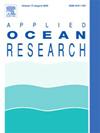Experimental study on the effect of an underground structure on the seismic responses of saturated coral sand site
IF 4.3
2区 工程技术
Q1 ENGINEERING, OCEAN
引用次数: 0
Abstract
Understanding the effect of underground structures on the seismic responses of saturated coral sand sites is crucial for improving seismic design and preventing liquefaction disasters in island reef engineering. Despite advancements in this field, the specific effects of underground structures on the seismic behavior of coral sand sites remain underexplored. This study addresses this issue by conducting dynamic centrifuge shaking table tests on saturated coral sand sites, both with and without an underground structure. The seismic responses between the free field (FF) and structure field (SF) were compared in terms of pore pressure, acceleration, response spectra, and shear stress-strain behavior. Test results reveal that the presence of the underground structure led to a deeper liquefaction zone beneath it. The excess pore pressure in the soil layer above the structure dissipated rapidly after peaking and completely dissipated by the end of the seismic motions. Additionally, the soil near the bottom of the structure exhibited higher dilatancy. The structure amplified the acceleration of the soil above and near its bottom while reducing the acceleration of the soil adjacent to its sidewall. In the period range of 0.9–3.0 s, the presence of the structure weakened the attenuation of response spectra values for the soil adjacent to the sidewall and above the structure. Furthermore, the structure limited the deformation of the soil adjacent to its sidewall and increased the soil shear modulus.
求助全文
约1分钟内获得全文
求助全文
来源期刊

Applied Ocean Research
地学-工程:大洋
CiteScore
8.70
自引率
7.00%
发文量
316
审稿时长
59 days
期刊介绍:
The aim of Applied Ocean Research is to encourage the submission of papers that advance the state of knowledge in a range of topics relevant to ocean engineering.
 求助内容:
求助内容: 应助结果提醒方式:
应助结果提醒方式:


